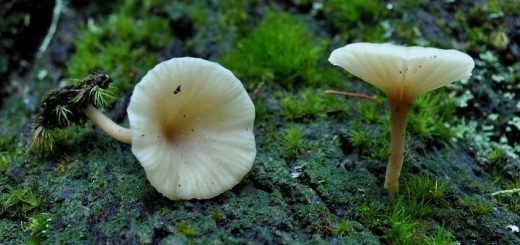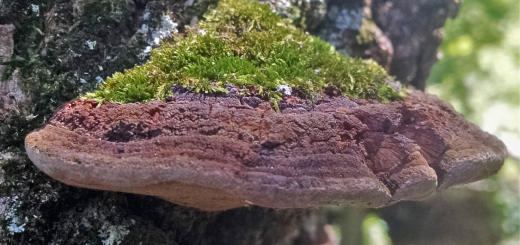#125: Hypholoma sublateritium, the Brick Cap
“Is this mushroom edible?” What a difficult question to answer. The world of edible mushrooms is littered with lookalikes, various degrees of edibility, mushrooms that are edible only under certain conditions, and mushrooms that no one has assessed for edibility. For Hypholoma sublateritium, the question is even more complicated. There is no consensus on whether or not Brick Caps are edible. North American field guides are divided on the issue and European field guides usually list these mushrooms as inedible or poisonous. In my local mushroom club, they are considered edible and are a welcome find in the late fall, when it is usually slim pickings for mushrooms. Because of this ambiguity, community is an essential part of mushroom hunting (despite its culture of secrecy and competition). If you are serious about mushroom hunting, you should be involved with a local mushroom club to ensure that you learn information about mushrooms relevant to the area in which you live.
H. sublateritium is known as the Brick Cap because its pileus is colored brick red. In fact, its species name means “somewhat brick-colored.” European authors (as well as Wikipedia) treat this species as synonymous with H. lateritium, whose species name simply means “brick-colored.” If these two names do in fact represent the same species of mushroom, it would make sense to use the name H. lateritium, as that one more accurately reflects the mushroom’s common name. Either way, kudos to the mycologists who named these mushrooms for keeping things simple.
The Brick Cap is a small to medium-sized mushroom. It grows to between 3 and 10cm (1-4in) across and 4-12cm (1.5-5in) tall. This mushroom’s most noticeable feature is its cap, which is colored an attractive brick red. The color fades toward the margin, becoming pinkish to whitish. Although the cap is hemispherical in shape when young, it usually flattens out as the mushroom matures. The cap is smooth and dry to somewhat most. Occasionally, you can find white tufts of fibers along the cap’s margin that are remnants of the partial veil.
On the underside of the cap, the gills radiate out from the central stipe. The gills meet the stipe at roughly a 90° angle (“attached”). At first the gills are white, but they soon become grayish and develop purple-gray to purple-brown colors as the spores mature. Brick Caps frequently produce short-gills, which are formed later and do not reach all the way to the stipe. In very young specimens, the gills are covered by a thick, whitish, cobwebby membrane called a partial veil. This membrane protects the developing gills.
The Brick Cap’s stipe is roughly the same width (1-2cm) all the way down, though it is often pinched at the base because the mushrooms usually form in tight clusters. Due to this growth pattern, the stipe is often twisted to ensure adequate space for cap growth. The stipe is yellowish or whitish near the top and becomes reddish to brown towards the bottom. Aside from the presence of a ring zone, the stipe is smooth and undecorated. The ring zone is formed when the partial veil collapses around the stipe. It is fairly insubstantial and may not persist in some specimens. In older mushrooms, the presence of a ring zone can help you identify the spore print color. A newly-formed ring will be whitish, but it becomes purple-brown with spores that get stuck in its fibers. Alternatively, you can check the caps of lower mushrooms in the cluster. The parts of mushroom caps underneath other Brick Caps will often be covered with a powdery layer of purple-brown spores.
H. sublateritium decomposes logs and stumps of hardwoods in North America, Europe, and parts of Asia. The mushrooms appear in the late summer through early winter, usually in dense clusters. In my area, they were even fruiting in early January this year, thanks to the unseasonably warm weather.
There are a few poisonous mushrooms that could be confused with Brick Caps. The easiest ones to mistake for brick caps are other members of the genus Hypholoma that grow in clusters on wood. These mushrooms have caps sporting yellow, orange, and brown colors and are usually found growing on conifer wood. This should easily distinguish them from the red and pink colors and hardwood habitat of the Brick Cap. When collecting mushrooms from wood, you should always be on the lookout for the Deadly Galerina (see FFF#124). Luckily, this mushroom is brown and has no traces of red in its cap. It also has a brown spore print, as opposed to the purple-brown spores of the Brick Cap. In my experience, Leratiomyces ceres can also be confused with H. sublateritium. L. ceres has red and orange shades on its cap, grows exclusively in wood mulch, and usually does not grow in dense clusters. These features should make it relatively easy to tell L. ceres apart from the Brick Cap.
As mentioned above, there is no consensus on the Brick Cap’s edibility. Some sources (mostly European) list H. sublateritium as poisonous, but I am unaware of any reports of food poisoning after eating this mushroom. The main complaint from North American authors is that Brick Caps are often too bitter to eat. This feature is not consistent and may be related to the mushroom’s age or presence of bugs or other decay organisms. If you are interested in eating Brick Caps, most people recommend you pick only young specimens. As an added precaution, the Michigan Mushroom Hunters Club suggests that you cook Brick Caps separately to avoid spoiling the rest of your food with a potentially bitter flavor. Interestingly, a few companies sell kits for growing H. sublateritium. This indicates that in some areas there is enough interest in eating Brick Caps to make cultivation of the species a worthwhile business endeavor.
See Further:
http://www.first-nature.com/fungi/hypholoma-lateritium.php
http://www.mushroomexpert.com/hypholoma_sublateritium.html
http://www.rogersmushrooms.com/gallery/DisplayBlock~bid~6202.asp
http://blog.mycology.cornell.edu/2006/10/25/hypholoma-sublateritiumedible/









![#011: Characteristics of Kingdom Fungi [Archived]](https://www.fungusfactfriday.com/wp-content/themes/hueman/assets/front/img/thumb-small-empty.png)

3 Responses
[…] as the Winecap or King Stropharia, and is actually cultivated in Europe. Hypholoma sublateritium (FFF#125), the Brick Cap, is sometimes considered edible and other times labeled poisonous, but is probably […]
[…] sublateritium (FFF#125) is another edible mushroom that fruits in clusters from downed logs in the fall. The Brick Cap […]
[…] other fungi in Hypholoma. Hypholoma species typically grow in clusters (think Brick Caps – FFF#125 – or the Sulfur Tuft), so the solitary H. tuberosum seems out of place in the genus. H. […]